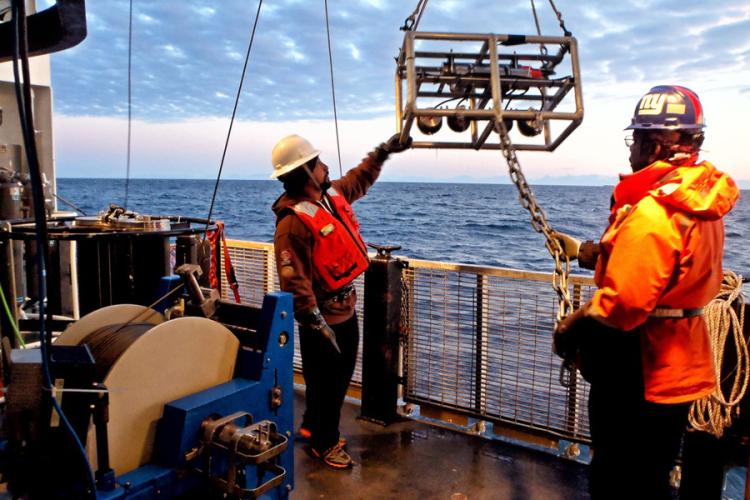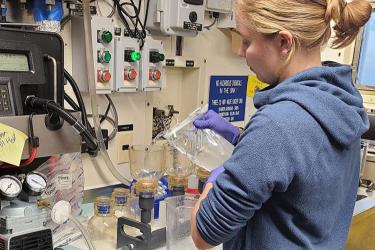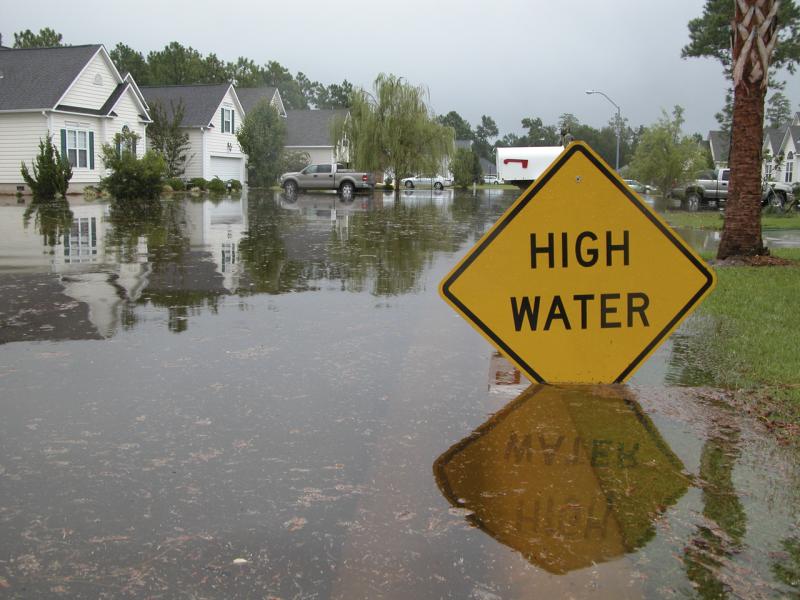NOAA Fisheries is seeking public comment on regional action plans to implement its national Climate Science Strategy to understand and respond to climate change. These documents are open for public comment until July 29, 2022.
Alaska Climate Science Regional Action Plans
Alaska Fisheries Science Center has taken the approach to develop separate regional action plans for each Large Marine Ecosystem (LME) under its purview. Previously, we developed regional action plans for the Eastern Bering Sea and Gulf of Alaska regions, while working to develop the Arctic Regional Action Plan, now known as the Beaufort and Chukchi Seas Regional Action Plan.
In each of these plans, NOAA Fisheries scientists share their research priorities for ongoing, proposed and needed research over the next three-years for each of these large marine ecosystems.
We welcome input from Alaska community members on research areas needed to advance our common understanding of how climate change is impacting Alaska marine ecosystems and communities.
Eastern Bering Sea
Large changes in ocean conditions are projected in the Bering Sea. Such changes may have cascading impacts on regional food-webs. The Eastern Bering Sea supports some of the most valuable commercial fisheries in the world and subsistence harvests are a critical resource for coastal communities. High numbers of seabirds and marine mammals also are found in the region. Climate-related changes in ocean and coastal ecosystems likely will impact the plankton, fish, seabirds, and marine mammals of the southeastern Bering Sea, as well as the people, businesses, and human communities that depend on them. Actionable information on when and how climate change will impact Alaska is needed.
- Eastern Bering Sea Regional Action Plan Overview (508 PDF, 2 pages)
- Draft Eastern Bering Sea Regional Action Plan
Gulf of Alaska
The Gulf of Alaska is an arm of the Pacific Ocean delineated by the curve of the southern coast of Alaska, extending from Alexander Archipelago in the east to the Alaska Peninsula in the west. From end to end the Gulf of Alaska extends 1500 miles (approximately 2414 kilometers). This is approximately the same length as the entire Atlantic seaboard.
- Gulf of Alaska Regional Action Plan Overview (508 PDF, 2 pages)
- Draft Gulf of Alaska Regional Action Plan
Beaufort and Chukchi Seas
Polar Amplification results in greater changes in atmospheric temperatures than temperate or tropical regions given increased greenhouse gas concentrations, and this has resulted in declining summertime sea ice throughout Arctic LMEs including the Chukchi and Beaufort Seas. Human impacts on global climate are driving changes in spatial distribution and productivity for fish and marine mammals worldwide and in the Arctic in particular, with resulting impacts on human livelihoods and subsistence.
The North Pacific Fishery Management Council (NPFMC) defines a Fishery Management Plan for the Fish Resources of the Arctic Management Area for the US Exclusive Economic Zone (EEZ) of the Beaufort and Chukchi Seas. Here, we use these same geographic boundaries to define and name the draft plan. The NPFMC developed the Arctic Fishery Management Plan in 2009. This plan prohibits commercial fishing (excluding salmon and halibut) "until sufficient information is available to support the sustainable management of a commercial fishery."
Chukchi Sea
The Chukchi Sea is a broad, relatively shallow (0-50 meters depth) shelf punctuated by canyons and shoals. Sea ice covers the Chukchi Sea each winter, and by late summer, sea ice retreats and open water occurs over most of the shelf. There is very high interannual variability in sea ice extent and timing of retreat. The timing of seasonal sea ice retreat has important impacts on the Chukchi Sea ecosystem. The typical timing of seasonal ice melt and onset of stratification coupled with nutrient-rich waters results in early spring blooms with little pelagic grazing such that a large amount of in situ and advected pelagic production sinks to the seafloor supporting a diverse and biomass rich benthic community.
Beaufort Sea
The Beaufort Sea includes a narrow nearshore shelf in the west that widens to the east and is connected to deep offshore basins via a relatively steep slope. Oceanographically, the region is influenced by warm nutrient-rich waters that flow eastward from the Chukchi Sea, the Beaufort Gyre, and freshwater input primarily from the Mackenzie River that impacts surface water salinity and stratification. Cross-shelf exchange via upwelling and eddies can bring deeper waters such as Atlantic origin water, nutrients, and organisms onto the shelf. Ice cover is seasonal, and summer sea ice has declined in recent decades. Rapid shifts in sea ice are strongly influenced by wind speed and direction, with increased easterly winds advecting sea ice out of the region. Changes in sea ice also impact wind-forced seasonal upwelling along the self break.
- Beaufort and Chukchi Seas Regional Action Plan Overview (508 PDF, 2 pages)
- Draft Beaufort and Chukchi Seas Regional Action Plan
Public Comment Period
These documents are open for public comment until July 29, 2022.
We welcome input from Alaska community members on research areas needed to advance our common understanding of how climate change is impacting Alaska marine ecosystems and communities.
The goal is to advance science that enables communities and resource managers plan and adapt to ensure sustainability of Alaska's living marine resources and the coastal communities that rely on them.
Information on how to submit public comments can be found here.





